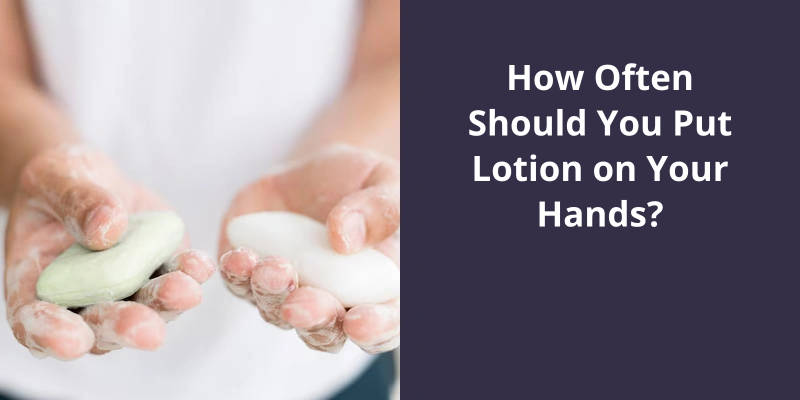You should apply lotion on your hands as often as needed, but typically a good rule of thumb is to moisturize at least once to twice a day. Paying attention to your hands’ dryness level can also guide you. It’s essential to apply lotion after washing your hands, as the water and soap can strip the skin of its natural oils. If your hands are exposed to harsh chemicals or weather conditions, you may need to apply lotion more frequently. Lastly, always remember to apply lotion before bed, so it can absorb and repair the skin overnight.

How Much Should You Moisturize Your Hands?
Moisturizing your hands is essential to maintain their health and prevent dryness, cracking, and irritation. It’s recommended to apply hand cream immediately after washing your hands, as this is when they’re most susceptible to moisture loss. Every time you visit the loo and cleanse your hands, it’s crucial to replenish the moisture barrier by applying a hydrating lotion.
However, it isn’t just after each wash that you should be reaching for your hand cream. Throughout the day, your hands can be exposed to various factors that can cause dryness, such as harsh soaps, cold weather, frequent hand washing, or using alcohol-based sanitizers. If you notice your hands feeling dry or dehydrated, it’s a sign that they need some extra hydration. Apply a small amount of hand cream and gently massage it into your skin to replenish moisture and nourish your hands.
For instance, if you work in an air-conditioned office, the dry indoor air can strip the moisture from your skin. Similarly, if youre in a profession where you frequently handle chemicals or wash your hands excessively, it’s crucial to apply hand cream throughout the day to counteract the drying effects.
It’s also worth noting that not all hand creams are created equal. Look for a product containing nourishing ingredients like shea butter, glycerin, or ceramides that can deeply hydrate and repair the skin barrier. Additionally, consider a hand cream with SPF to protect your hands from harmful UV rays, even on cloudy days.
The frequency at which you should apply hand cream depends on several factors, such as how often you wash your hands, your environment, and your individual skin type. However, as a general rule, it’s recommended to moisturize your hands every time you wash them and whenever they feel dry or dehydrated. By making hand cream application a regular part of your skincare routine, you can keep your hands soft, supple, and healthy.
Instead, it’s more effective to apply lotion to slightly damp skin, such as right after showering or bathing. This allows the lotion to lock in moisture and keep your skin hydrated throughout the day. By following this simple routine, you can enjoy soft and nourished skin without constantly reapplying lotion.
How Many Times Do You Use Lotion a Day?
Instead, it’s recommended to apply body lotion immediately after showering or bathing when your skin is still damp. This helps to lock in moisture and allows the lotion to penetrate deep into the skin. By doing this once a day, you can effectively moisturize your skin and keep it hydrated throughout the day.
It’s also worth noting that the type of lotion you use can impact how often you should apply it. For example, if you use a lightweight, fast-absorbing lotion, you may need to apply it more frequently compared to a thicker, more moisturizing cream. Additionally, if you engage in activities that can dry out your skin, such as frequent handwashing or exposure to harsh weather conditions, you may need to apply lotion more often to counteract the drying effects.
If your skin feels dry, tight, or itchy, it may be a sign that you need to moisturize more frequently. On the other hand, if your skin feels greasy or heavy after applying lotion, you may be using too much or not allowing enough time for it to absorb. By finding the right balance, you can keep your hands moisturized and nourished, promoting healthy and youthful-looking skin.
Different Types of Lotions and Their Effects on the Skin.
There are different types of lotions available in the market, each catering to specific skin needs. Moisturizing lotions are designed to replenish hydration and prevent dryness, making them ideal for people with dry skin. On the other hand, lightweight lotions are suitable for those with oily skin as they provide moisture without clogging pores.
Anti-aging lotions often contain ingredients like retinol, peptides, or antioxidants to reduce the appearance of wrinkles and fine lines. These lotions work best for individuals concerned about signs of aging. For individuals with sensitive skin, fragrance-free and hypoallergenic lotions are recommended to prevent irritation or allergic reactions.
The frequency of applying lotion on your hands, and any part of the body, depends on personal preference and skin requirements. As a general rule, applying lotion at least once or twice a day is sufficient to maintain well-hydrated skin. However, factors such as climate, hand washing frequency, or skin conditions may influence the need for more frequent application.
Others may prefer to apply hand cream only at night before bed, allowing it to deeply moisturize the skin while they sleep. The frequency of hand cream usage largely depends on individual preferences and the specific needs of your hands. Ultimately, it’s important to find a routine that works best for you, ensuring that your hands remain well-hydrated and protected throughout the day.
How Much Hand Cream Per Day?
When it comes to determining the appropriate amount of hand cream to use in a day, there’s no set rule or one-size-fits-all approach. The frequency of application varies from person to person depending on various factors such as skin type, climate, and individual preferences.
For those with dry or sensitive skin, using hand cream after every hand wash can provide much-needed hydration and protection. Washing hands frequently can strip the skin of it’s natural oils, leading to dryness and discomfort. Applying hand cream after each wash helps replenish the lost moisture and maintain the skins integrity.
In such cases, sporadic application throughout the day can suffice. This could mean applying hand cream whenever the skin feels dry, tight, or irritated or after exposure to harsh environmental conditions like cold weather or excessive handwashing.
It’s important to note that the amount of hand cream used in each application matters just as much as the frequency. Applying a pea-sized amount of hand cream is usually sufficient to cover the hands adequately. Too much cream can leave a greasy residue and make daily activities challenging, while insufficient application may not provide the desired level of moisturization.
Ultimately, the key is to find a routine that works best for your skin type and lifestyle. Listen to your skins needs and adjust your hand cream usage accordingly. If your hands feel consistently dry, it may be a sign that you need to increase the frequency or amount of hand cream used. Conversely, if your hands feel overly greasy or appear to have a buildup of product, it may be an indication to scale back a bit.
Remember that hand cream isn’t just a luxury but an essential self-care step to maintain healthy and comfortable skin. By regular moisturization, you can keep your hands soft, supple, and well-protected, regardless of the specific frequency that suits your needs.
How to Choose the Right Hand Cream for Your Skin Type?
Choosing the right hand cream for your skin type is essential for keeping your hands moisturized and healthy. Here are a few tips to help you find the perfect hand cream:
1. Determine your skin type: Whether you’ve dry, sensitive, oily, or normal skin, knowing your skin type will help you select a hand cream that addresses your specific needs.
2. Read the ingredients: Look for hand creams that contain moisturizing ingredients such as glycerin, hyaluronic acid, shea butter, or ceramides. Avoid products that contain harsh ingredients or potential irritants.
3. Consider the season: In colder months, opt for a thicker, more emollient hand cream to combat dryness. In warmer months, lighter formulas or lotions may be more comfortable to use.
4. SPF protection: If you spend a lot of time outdoors, choose a hand cream with added SPF to protect your skin from harmful UV rays.
5. Fragrance preferences: Some hand creams have fragrance, while others are unscented. Consider your personal preference and any sensitivities you may have to scents.
Remember to apply hand cream regularly throughout the day, especially after washing your hands, to keep them soft, smooth, and hydrated.
Moisturizing your skin is an essential step in any skincare routine, but how often should you actually be using moisturizer? The answer to this question is simple: it depends on your skin type and individual needs. While some people may only need to apply moisturizer once or twice a day, others may benefit from using it three times a day. Regular application helps to maintain the moisture balance of your skin and keep it hydrated throughout the day. However, it’s important to note that over-moisturizing can lead to clogged pores and other skin issues, so it’s important to listen to your skin and adjust your routine accordingly.
Can I Use Moisturizer 3 Times a Day?
Dry skin types may require more frequent application of moisturizer, especially during the winter months when the air is dry and can further dehydrate the skin. In contrast, those with oily skin may find that applying moisturizer twice a day is sufficient to maintain balanced hydration levels.
It’s important to note that overuse of moisturizer can be counterproductive. Applying excessive amounts or using it too frequently can lead to clogged pores, greasiness, or even breakouts. It’s crucial to listen to your skins needs and adjust your moisturizer usage accordingly.
Ultimately, the key is to observe how your skin responds to the frequency of moisturizer application. If you notice that your skin feels hydrated and supple throughout the day, you’re likely using moisturizer at an appropriate frequency. If you experience dryness, tightness, or flakiness, consider increasing the number of times you apply moisturizer.
The Benefits and Drawbacks of Using Moisturizer With SPF for Daily Sun Protection.
- Protects the skin from harmful UVA and UVB rays
- Prevents sunburn and reduces the risk of skin cancer
- Moisturizes and hydrates the skin
- Helps to prevent premature aging and the formation of wrinkles
- Can be easily incorporated into your daily skincare routine
- Provides a convenient two-in-one solution for sun protection and skincare
- May help to improve the overall appearance and texture of the skin
- Acts as a barrier against environmental pollutants
- Enhances the effectiveness of other skincare products used in conjunction
- May cause skin irritation or allergic reactions in some individuals
- Requires frequent reapplication throughout the day for maximum effectiveness
- May leave a white cast or greasy residue on the skin
- Can be more expensive compared to standalone sunscreen products
- Some moisturizers with SPF may not offer sufficient sun protection
- May not be suitable for all skin types, especially oily or acne-prone skin
Taking care of your hands goes beyond just cleanliness. Using hand lotion regularly offers numerous benefits. Not only does it restore moisture to your skin, but it also acts as a preventive measure against premature aging and shields your hands from harmful sun exposure.
Is It Necessary to Use Hand Lotion?
Is it necessary to use hand lotion? Many people often overlook the importance of regularly moisturizing their hands, considering it as a mere luxury rather than a necessity. However, using hand lotion has numerous benefits that go beyond simple indulgence. By applying a hand cream regularly, you can’t only boost the moisture levels in your skin but also prevent premature aging and protect your skin from harmful sun exposure.
Our hands are constantly exposed to various elements, such as harsh soaps, hot water, cold weather, and dry air. These factors can lead to dryness, cracking, and roughness of the skin. Regular use of hand lotion helps to soothe and hydrate the skin, replenishing the lost moisture and restoring it’s elasticity. Dry hands aren’t only uncomfortable but can also lead to more serious conditions such as eczema or dermatitis. Therefore, keeping your hands moisturized is vital for maintaining healthy skin.
Additionally, applying hand cream can also significantly slow down the signs of aging on your hands. The thin skin on the hands is prone to wrinkles and age spots, which can make you appear older than you actually are. By keeping your hands well-moisturized, you can promote collagen production and maintain the youthful appearance of your hands. Look for hand creams that contain ingredients like retinol or hyaluronic acid, known for their anti-aging properties.
Moreover, a good hand cream can act as a shield against harmful UV rays. We often neglect to protect our hands from sun exposure, which can lead to sunburns, pigmentation, and even skin cancer. Choose a hand cream that contains SPF to provide extra protection against the damaging effects of the sun. Regular application of a sunscreen-infused hand lotion won’t only keep your hands well-hydrated but also shield them from harmful UV radiation.
Benefits of Using Natural/Organic Hand Lotions
- Moisturizes the skin without harsh chemicals
- Contains natural ingredients that nourish and protect the skin
- Helps to prevent dryness and roughness
- Gentler on sensitive skin
- Reduces the risk of allergic reactions
- Eco-friendly and sustainable
- Cruelty-free and not tested on animals
- Free from synthetic fragrances and dyes
- May have soothing properties for irritated skin
- Doesn’t contribute to the harmful effects of chemical pollution
Source: Everything you need to know about hand creams – BeBeautiful
Conclusion
In conclusion, maintaining proper hand care and hydration is essential for keeping our hands healthy and protected. However, it’s particularly crucial to use them before bedtime and in the morning.





